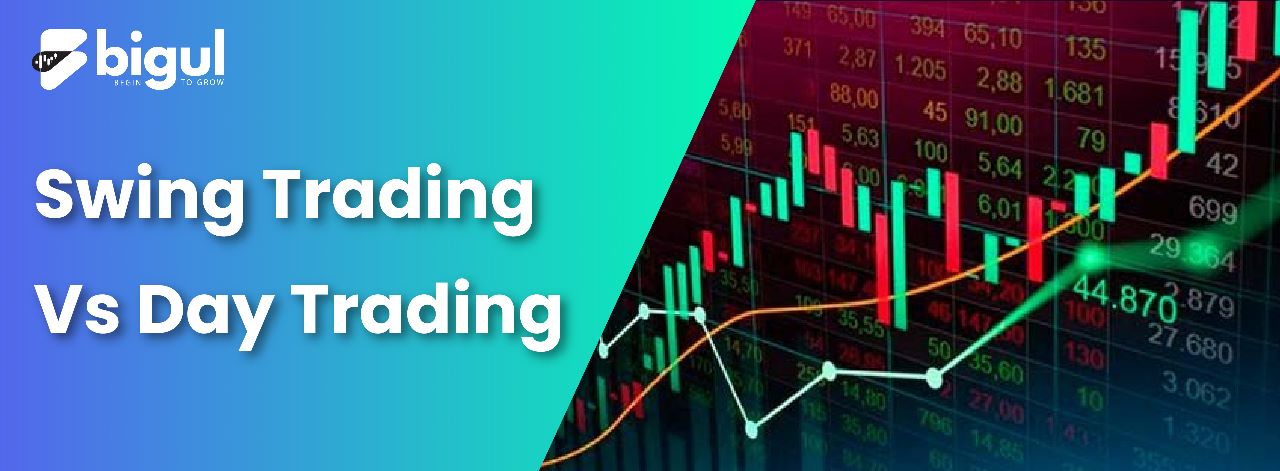Investing and trading are two key ways market participants profit from the financial markets. While long-term investing allows for wealth-building through holding securities, trading offers opportunities to capitalise on short-term volatility.
Among various trading methods like standard, momentum, and intraday trading, two popular approaches are Day trading and Swing Trading.
This article aims to shed light on the distinctions between Day trading and Swing Trading, the capital required for each style, and help readers determine which trading method, especially swing trade stocks, aligns best with their financial goals.
What is Swing Trading?
Swing trading is a short- to medium-term trading strategy where traders aim to profit from price swings or “swings” in financial markets.
Holding positions for a few days to weeks, swing traders analyse technical indicators and chart patterns to identify potential entry and exit points. They seek to capitalise on market fluctuations, often avoiding long-term trends.
The strategy requires active monitoring and quick decision-making to capture profits from upward and downward price movements.
What is Day Trading?
Day trading is a form of speculative trading where individuals buy and sell financial instruments within the same trading day.
Traders aim to profit from short-term price movements, taking advantage of volatility and leveraging various strategies and tools. It requires quick decision-making, market analysis, and risk management. Day traders leverage their trades in stocks and currency. , and cryptocurrencies.
Day trading requires expertise, dedication, and market knowledge, but it also poses high risks due to its fast speed and potential for large losses.
Differences Between Swing Trading and Day Trading
Swing and day trading are two popular trading strategies in financial markets. Both approaches aim to profit from short-term price movements but differ regarding trading frequency, time horizon, risk management, and overall trading strategies.
Here are the key differences between swing trading and day trading:
Time Horizon
- Day Trading: Day traders open and close their positions within the same day. They do not hold any positions overnight, meaning all trades are executed and closed on the same day.
- Swing Trading: Swing traders hold their positions longer, typically from a few days to a few weeks. They aim to profit from short- to medium-term price fluctuations.
Trading Frequency
- Day Trading: Day traders execute multiple trades throughout the day, often making several trades within minutes or hours.
- Swing Trading: Swing traders execute fewer trades than day traders since they hold positions for a longer duration.
Risk Tolerance
- Day Trading: Due to the quick and frequent nature of day trading, it can be riskier. Day traders need to make split-second decisions, which can lead to higher stress levels and emotional pressure.
- Swing Trading: Swing trading allows more time to analyse trades and make decisions. It might involve lower stress levels as positions are held more extended.
Trading Strategies
- Day Trading: Day traders often use technical analysis to identify short-term price patterns and trends. They rely on charts, indicators, and real-time market data for quick decision-making.
- Swing Trading: Swing traders also use technical analysis but focus on identifying medium-term trends and price swings. They might use a combination of indicators and chart patterns to make their trades.
Overnight Risk
- Day Trading: Day traders do not hold positions overnight, so they are not exposed to the risks of overnight price movements or news events.
- Swing Trading: Swing traders hold positions overnight, exposing them to potential gaps in price due to news announcements or other market-moving events.
Capital Requirements
- Day Trading: No fixed rule for a minimum capital requirement exists.
- Swing Trading: Swing trading might require less capital since traders do not need to meet the same minimum equity requirements as day traders.
Time Commitment
- Day Trading: Day trading demands constant attention during market hours, making it suitable for those who can dedicate their entire day to trading.
- Swing Trading: Swing trading allows for a more flexible schedule, as traders can analyse the markets and manage their positions outside market hours.
Which One is Better for You?
In the financial market, both day and swing trading have advantages and risks. Your choice of trading strategy should align with your investment goals, knowledge, and experience. If you have been in the market for a long time, possess quick decision-making skills, high-stress tolerance, risk-taking attitude, passion for trading, and the time to dedicate, day trading might be suitable.
On the other hand, swing trading is a better option if you are a beginner, prefer a more relaxed decision-making pace, have lower stress tolerance, and cannot dedicate extensive time to monitoring the markets.
Swing trading allows you to profit from short-term market movements without requiring constant monitoring. Ultimately, selecting the right strategy depends on your circumstances and preferences.
Conclusion
Understanding the differences between swing and day trading is crucial when it comes to beginners’ trading. Swing trading offers a more relaxed approach, allowing individuals to learn and adapt to the market with lower stress levels and a longer decision-making timeframe.
On the other hand, day trading demands quick thinking, high-stress tolerance, and significant time dedication. Novice traders can start with swing trading to gain experience and gradually transition to day trading if they feel confident in their skills and risk-taking abilities.







.jpg)
.jpg)
